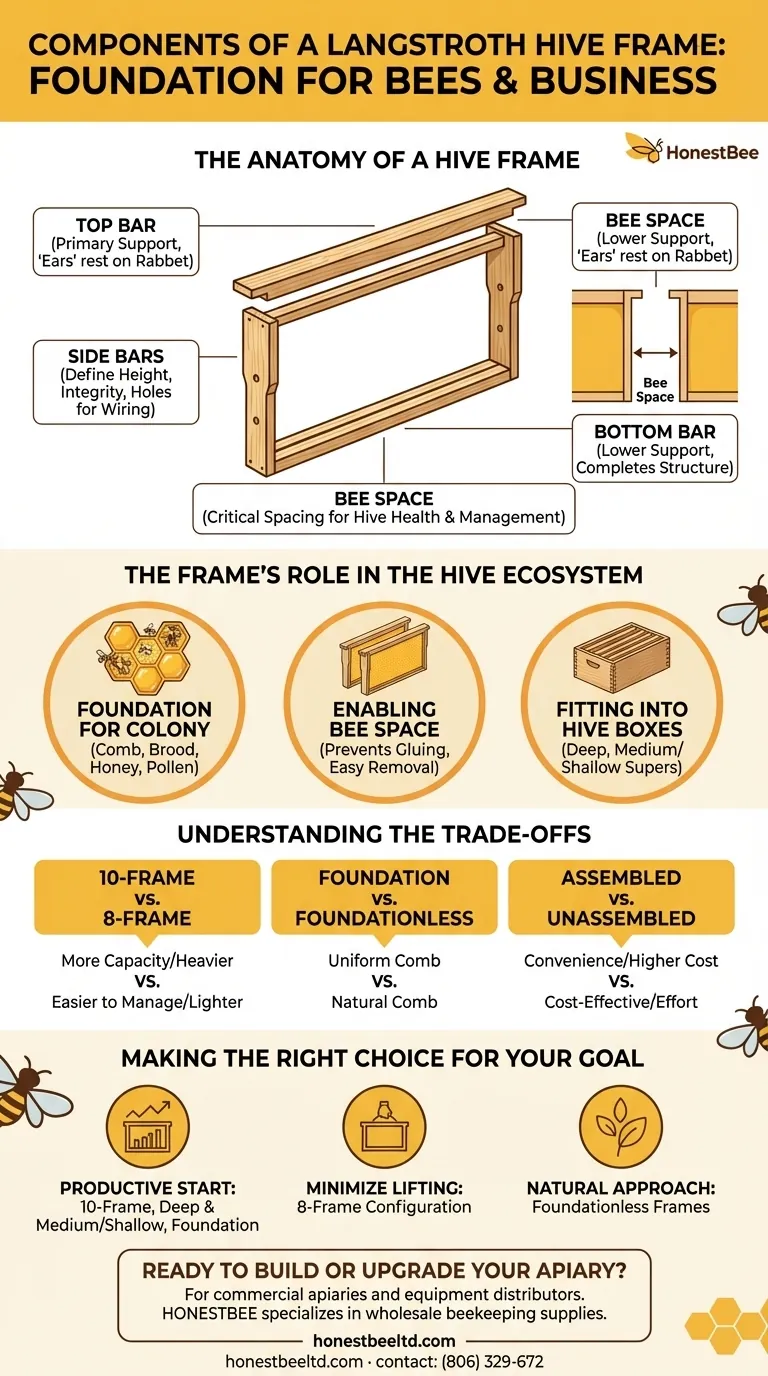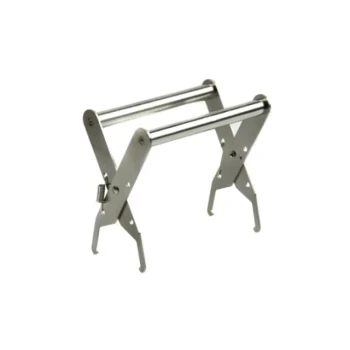At its most basic, a frame in a Langstroth hive is a simple rectangular structure made of four key parts. These are the top bar, two side bars, and a bottom bar. When assembled, this rectangle is designed to hold the honeycomb, creating a removable and inspectable unit that is the foundation of modern beekeeping.
The hive frame is more than just a wooden rectangle; it is the fundamental component that makes hive management possible. Its standardized dimensions allow beekeepers to easily inspect, move, and harvest from the hive without destroying the colony's structure.

The Anatomy of a Hive Frame
Each part of the frame serves a specific and critical function. Understanding these components is the first step to understanding how the entire hive operates as a system.
The Top Bar
The top bar is the primary support structure for the entire frame. It features protruding ends, often called "ears," which rest on a recessed ledge known as a rabbet inside the hive box. This allows the frame to hang securely, suspended within the box.
The Side Bars
The two side bars define the height and structural integrity of the frame. They connect the top bar to the bottom bar, creating the rectangular shape. Many side bars include small holes for threading wire, which provides extra reinforcement for the wax or plastic foundation placed inside.
The Bottom Bar
The bottom bar completes the frame, providing lower support for the comb. While it bears less weight than the top bar, it is essential for maintaining the frame's rigidity and ensuring the comb is fully enclosed.
The Frame's Role in the Hive Ecosystem
A single frame is useless on its own. Its true purpose is realized when it works in concert with other frames inside a hive box.
A Foundation for the Colony
The frame's primary purpose is to hold a sheet of foundation (wax or plastic) or to provide a guide for bees to build their own honeycomb. This comb is where the queen lays her eggs (brood) and where the bees store honey, pollen, and nectar.
Enabling "Bee Space"
The genius of the Langstroth design is its precise spacing. When frames are placed in a hive box, they are spaced apart by a specific distance—known as bee space. This gap is just wide enough for bees to move freely but too narrow for them to build unwanted comb, which prevents the frames from being glued together and makes them easily removable.
Fitting into the Hive Boxes
Frames come in different depths to match the different sizes of hive boxes. Deep frames are used in deep hive bodies (brood boxes), which house the queen and brood. Medium and shallow frames are used in smaller boxes called "supers," which are stacked on top for honey storage.
Understanding the Trade-offs
Choosing frame components involves several key decisions, each with its own advantages and disadvantages.
10-Frame vs. 8-Frame Equipment
The standard Langstroth hive holds 10 frames per box. However, an 8-frame option is also common. A 10-frame hive offers more space for brood and honey, but the boxes become significantly heavier when full. An 8-frame hive is easier to lift and manage, making it a popular choice for beekeepers with physical limitations.
Foundation vs. Foundationless
You can place a sheet of wax or plastic foundation inside the frame to give bees a guide for building comb. This leads to very straight, uniform combs. Alternatively, you can use foundationless frames, which simply provide a top guide and allow bees to build their comb naturally, a practice common in more "natural" beekeeping styles.
Assembled vs. Unassembled
Frames can be purchased pre-assembled or as a kit of parts (unassembled). Buying unassembled frames is more cost-effective but requires time and effort to nail and glue them together. Pre-assembled frames are ready to go but come at a higher cost.
Making the Right Choice for Your Goal
The frames you choose are directly tied to your beekeeping goals and management style.
- If your primary focus is a standard, productive start: Begin with 10-frame equipment using deep frames for your brood box and medium frames for your honey supers, installing wax or plastic foundation in each.
- If your primary focus is minimizing heavy lifting: Choose an 8-frame hive configuration, which keeps the weight of each box manageable.
- If your primary focus is a more natural approach: Consider using foundationless frames to allow the bees to build their comb according to their own instincts.
Ultimately, mastering the simple hive frame is the key to understanding, managing, and supporting a healthy and thriving bee colony.
Summary Table:
| Component | Function | Key Feature |
|---|---|---|
| Top Bar | Primary support structure | Features 'ears' that rest on the hive box's rabbet |
| Side Bars | Define frame height and integrity | Often include holes for wiring reinforcement |
| Bottom Bar | Provides lower support and rigidity | Completes the rectangular structure for the comb |
Ready to build or upgrade your apiary with the right equipment?
For commercial apiaries and equipment distributors, having a reliable supply of high-quality, durable hive frames is critical for operational success. HONESTBEE specializes in wholesale beekeeping supplies and equipment, providing the robust foundation your business needs to thrive.
Contact HONESTBEE today to discuss your bulk supply needs and ensure your colonies have the best support system from the ground up.
Visual Guide

Related Products
- Professional In-Hive Bee Feeder HONESTBEE Frame for Beekeeping
- Assembled Wooden Bee Frames with Beeswax Foundation Ready to Use by HONESTBEE
- Plastic Bee Frame Beekeeping Hive Frames for Wholesale
- Stainless Steel 9 Frame Hive Spacer Durable Precise for Commercial Beekeeping
- Professional Bee Frame Wiring Tool with Integrated Tensioning System by HONESTBEE
People Also Ask
- How do you feed bees outside the hive? Understanding the Risks and Safe Alternatives
- How does the design of Langstroth frames make them easier to operate? Leverage Bee Space for Efficient Hive Management
- Are frame feeders good? Maximize Your Hive's Health with the Right Feeding Strategy
- What are the advantages of using frames in a Langstroth hive? Achieve Superior Hive Management and Honey Production
- What is a frame in a Langstroth style beehive? The Key to Modern, Manageable Beekeeping



















